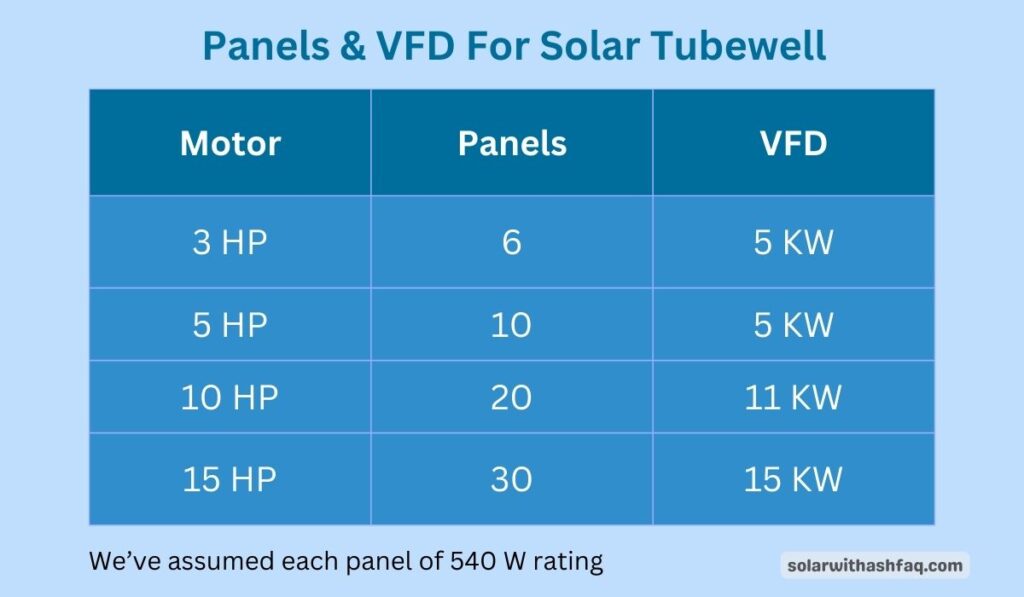How to Calculate Solar Panel for Water Pump
If you are among those planning to install a solar tube well for irrigation, then congrats!
You are making the right decision at the right time.
That being said, it is more important to size your solar panels and inverter (VFD) to match your tubewell pump.
Instead of complaining to your solar electrician after the system is installed.
In this guide, I’ll break down the steps needed to calculate the correct number of solar panels.
Find Trusted Solar Companies in Your City
No more guesswork! Compare expert-approved solar companies to safe-guard your investment.
Also Read: Solar Tubewell Price in Pakistan [2025 Guide]
Components of a Solar-Powered Water Pump System
I’m assuming that you already have a tubewell motor pump in place.
If you are going to install a new motor with solar panels, install a monoblock motor if your water level is 60 Feet, and if the water level is higher, install a submersible (Choa motor).
So, your solar-powered system consists of the following key components:
- Solar Panels
- VFD / Inverter
- Circuit Breakers (for protection)
Step-by-Step Solar Panel Size Calculation
Determine the Energy Requirement of the Pump
The first step is to know the power rating of the tubewell pump, which is measured in horsepower (HP).
Convert HP to Watts: 1 HP is approximately equal to 746 Watts. We’ll assume the pump is rated at 15 HP (commonly used pumps in Punjab).
The power requirement in watts would be:
Power (W) = HP × 746
Power (W) = 15×746
Power (W)= 11190 W
Power (KW) = 11 KW
Calculate Daily Energy Consumption: Now, estimate how many hours per day the pump will operate.
If it runs for 6 hours a day, the energy requirement in watt-hours (Wh) would be:
Daily Energy (KWh) = Power (W) × Hours of Operation
Daily Energy (KWh) = 11 (KW) × 6
Daily Energy (KWH) = 67 KWh
Estimate Solar Panel Output
The output of solar panels can be estimated based on the average solar peak hours. If you assume an average of 6, the output per panel can be calculated.
For a 540W panel:
Daily Output Wh =Panel Power W × Average Sunlight Hours
Assuming about 6 hours of effective sunlight:
Daily Output (Wh) = 540 W × 6
Daily Output (Wh) =3240 Wh
Daily Output (KWh) = 3.2 KWh
Practically your solar panels work around 70% efficiency due to effects like:
- Shading
- Changing Sun Intensity
- Dust and Soil on Panels
Daily Output Produced (KWh) = 3.2 KWh × 0.7
Daily Output Produced (KWh) = 2.2 KWh
Now, Calculate the Number of Panels Required
Divide the total daily energy requirement by the output of one solar panel to find out how many panels are needed.
Number of Panels = Daily Energy Consumption (KWh) / Daily Output Produced (KWh)
For our example:
Number of Panels = 67 (KWH) / 2.2 (KWh)
Number of Panels = 30
Thus, to meet the tubewell pump’s energy requirement, 30 solar panels, each 540 W, would be needed.
What Should be the Size of VFD (Inverter) for Tubewell
When selecting the VFD, ensure it can handle the load of the motor.
The VFD size is calculated as follows:
VFD Size (HP) = Motor (HP) × 1.5
VFD Size = 15 × 1.5
VFD Size = 22 HP
Now, convert this into KW as VFD are rated in KW:
VFD Size = 22 × 0.746
VFD Siz (KW) = 16 KW
But the available capacity in the market is 15 KW.
Thus, you would need a VFD rated for at least 15 HP.
Rule of Thumb: Choose the VFD in KW, which is the same as the motor’s Horsepower Rating. For example, a 15 HP motor needs a 15 KW VFD, and a 10 HP motor needs a 10 KW VFD.

Avoid These Common Mistakes
When designing a solar-powered water pump system, it is crucial to avoid the common mistakes.
Ignoring these can lead to bad performance and low water pressure.
Undersizing the System
Now, if someone says that he is running a 15 HP motor, just only 24 or 25 panels.
Well! that’s possible.
But the difference lies in the number of hours the motor will run in a day.
The more panels you use, the more time the motor will run in a day.
It is also wise to consider future energy needs and system expansions to prevent underestimating requirements.
Additionally, the pump must have sufficient power to meet your specific water flow and pressure needs.
Lastly, consulting with an experienced solar system installer locally is helpful as they will better asses your tubewell site.
Ignoring Seasonal Variations
Ignoring seasonal variations is a common mistake. Seasonal changes impact the performance of solar panels and the overall efficiency of the system.
For instance, during cloudy weather or rainy seasons, solar irradiance may be lower, resulting in reduced energy production from the solar panels.
This can lead to insufficient power for the water pump.
Additionally, water needs vary with crops; for example, rice crops demand more water while wheat crops need minimum water.
So keep in mind that if your panels are not able to meet that high demand, there should be an alternate source of water for your fields.
Concluding Thoughts
By carefully calculating your solar panel size for your water pump system, you’re well on your way.
So, take these insights and apply them to your specific situation to get rid of hefty power bills.
Frequently Asked Questions
The price of a 4-inch solar water pump ranges from Rs 48500 to Rs 70,000 depending upon the manufacturer.
Yes, solar panels can be used to power various types of water pumps, including submersible and surface pumps. However, it is crucial to ensure that the pump is compatible with the solar panel output.
Yes, you can use a solar-powered tubewell system without battery storage if you have sufficient water storage to meet your needs. In such cases, the system will operate during daylight hours when solar energy is available.
The initial investment includes the cost of solar panels, the water pump, VFD, and any necessary mounting hardware.
First, assess the pump’s power requirements and calculate the daily energy needs based on the hours of operation. Then, account for inefficiencies by multiplying the power requirement by 1.5 to 2, and divide this figure by the wattage of your chosen solar panels

Content Writer | Assistant Manager (Electrical) at IESCO
As a passionate content writer, I’m on a mission to make solar hassle-free for you through my expert guides and easy-to-digest content.

